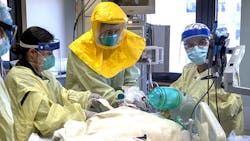Los Angeles County Ambulance Crews to Cut Back on Oxygen
By Alex Wigglesworth, Rong-Gong Lin II, Soumya Karlamangla and Luke Money
Source Los Angeles Times
Editor's note: Find Firehouse.com's complete coverage of the COVID-19 pandemic here.
LOS ANGELES—The situation in Los Angeles County hospitals is so critical that ambulance crews have been advised to try to cut back on their use of oxygen and not to bring to hospitals patients who have virtually no chance of survival. Officials now say they need to focus on patients with a greater chance of surviving.
The measures were taken as circumstances were expected to become even worse in coming weeks, when patients sickened over the Christmas holiday will need treatment, leaving officials desperate for ways to increase capacity and triage care to focus on the sickest patients.
Hospitals are moving to rapidly discharge ill patients who, in less-crowded situations, would normally be allowed to stay for continued observation. That has helped, but officials fear the flood of new patients — many with COVID-19 — is outpacing their ability to move less critical patients out.
In a sign of the strain the surge is putting on critical medical supplies needed for severely ill patients, the L.A. County Emergency Medical Services Agency issued a directive Monday that ambulance crews should conserve oxygen by administering it only to patients who had oxygen saturation levels below 90%.
To reduce demand on overwhelmed hospitals, the EMS agency last week also issued memos directing ambulance staff not to transfer to hospitals most patients who had virtually no chance of survival.
In pre-pandemic times, even those who had slim odds of pulling through were transported to the hospital, as there was capacity to accommodate even the most unlikely recovery scenarios.
Patients who are not to be transported to hospitals include those whose hearts have stopped and, despite efforts at resuscitation, have no signs of breathing, movement, a pulse or blood pressure, and would be declared dead at the scene. Paramedics and emergency medical technicians, obviously, are to continue to try to perform resuscitation in the field until a pulse can be restored, after which a patient could be stabilized and transported to the hospital.
Emergency rooms are already so slammed that some patients are having to wait inside ambulances for as long as eight hours for a bed to open. That backlog ties up ambulances and keeps them from being able to respond to other emergency calls — renewing concerns that some patients, such as those who have suffered a heart attack or stroke, are not being offloaded quickly enough.
To deal with the shortage, officials have devised an emergency plan to create temporary “ambulance-receiving spaces” — set up just outside the emergency room entrance and often covered by tents or canopies — to accept patients.
A paramedic or emergency medical technician may be used to assist with monitoring up to four patients in such areas, a change from the conventional practice of having one patient monitored by one ambulance staff member. Officials say the plan allows more ambulances to leave the hospital and return to circulation.
An ambulance-receiving space can be implemented only with permission from the L.A. County EMS Agency’s Medical Alert Center. The threshold is met only when all available patient treatment areas in the emergency room — including the hallways — are fully occupied and when at least three ambulances or at least three patients managed by EMTs or paramedics must wait for over an hour.
The additional measures illustrate the lengths to which hospitals in California’s most-populous county are going to contend with the crush of COVID-19 patients.
As of Sunday, the most recent day for which complete data are available, there were 7,898 coronavirus-positive patients hospitalized countywide, with 1,627 of them in intensive care.
Officials remain concerned that those numbers — already at all-time highs — will surge even higher by the end of this week or early next week, although case reports may be lower over the next few days because fewer people were tested over the holidays.
“Let‘s say we see cases rise to 17,000, 18,000, 19,000 a day, that means seven to 10 days later the hospitals are going to see a surge, and another week after that, deaths will also rise,” said Dr. Jeffrey Gunzenhauser, Los Angeles County’s chief medical officer.
Gunzenhauser said the county had been working with hospital executives, its Emergency Services Agency and the state to brace for that possibility.
“We are exploring collectively every possible way to reduce the burden on the hospitals,” he said. “There’s a lot of actions that have been taken to improve the coordination of identifying patients really needing hospitalization and linking them up to where there’s an available bed rather than stacking up ambulances outside an emergency department.”
He said the state had eased some administrative requirements on hospitals, such as the amount of charting required, to free staff so they could take care of more patients.
They are also working on identifying and removing barriers to discharging patients to lower levels of care.
“For example, there are beds available in some skilled nursing facilities,” Gunzenhauser said, “and we are doing everything possible to remove restrictions so patients who are well enough to be discharged from hospitals can move to those skilled nursing facilities.”
Skilled nursing facilities have been the site of coronavirus outbreaks, but Guzenhauser said officials were “trying to set it up so it could be safe as possible in regards to COVID transmission.”
Patients who could be moved could include those who suffered a heart attack or stroke and don’t need to stay in the hospital but have to go somewhere to receive intense nursing support, he said.
Such arrangements make more sense than setting up a field hospital or medical ship, as was done earlier in the pandemic, because the medical infrastructure and staff are already in place, he said.
“If you set up a tent or have a ship, you have to build everything else around it.”
The goal, Gunzenhauser said, is to keep hospitals in L.A. County from entering “crisis care” mode, in which medical rationing would occur.
“But if there is a surge in cases, there could be an additional 1,000 beds or more needed for COVID patients, which would be difficult to accommodate here in L.A.,” he said. “It’s hard to speculate, but we’re doing all we can to prepare for the worst.”
L.A. County’s ICUs are bursting at the seams. COVID-19 patients in intensive care units nearly tripled in December even as hospitals cut in half the number of ICU patients who were not coronavirus-positive. But that comes at a cost. For instance, one patient with a kidney transplant scheduled for mid-January at Cedars-Sinai Medical Center had his procedure postponed because of a lack of ICU beds.
On Wednesday, of the more than 2,000 occupied ICU beds in L.A. County, 77% were filled with COVID-19 patients. That’s a marked increase from Dec. 1, when 37% of the ICU beds were used by COVID-19 patients.
The situation is especially precarious when looking at specific regions.
Many hospitals are already reporting their ICUs as effectively full, and they have been forced to treat dying patients in emergency rooms and even hallways. On Wednesday, only 25 of the county’s staffed ICU beds were available, 1% of the total number of available beds.
That same day, there were no available ICU beds in the San Gabriel Valley or in southeast Los Angeles County. There were only three beds in southern L.A. County, representing less than 1% of all staffed ICU beds in a region that includes Long Beach and the South Bay area.
Between Christmas and Dec. 28, there were no ICU beds available in central L.A., which includes Cedars-Sinai Medical Center near Beverly Hills and L.A. County-USC Medical Center on the Eastside. On Dec. 26, there was only one ICU bed available on the Westside, a region that includes Ronald Reagan UCLA Medical Center in Westwood and Providence Saint John’s Health Center in Santa Monica.
On Sunday, an additional 11,513 new coronavirus cases were reported in the county, according to a Los Angeles Times count of local health jurisdictions. Over the last three days, L.A. County has reported an average of about 16,000 new coronavirus cases a day, among the highest numbers in all of the pandemic.
Also, an additional 85 COVID-19 deaths were reported Sunday, the latest in a grim holiday season that saw the highest single-day death tallies in the last week, including 242 on Tuesday, 262 on Wednesday, 291 on New Year’s Eve and 193 on New Year’s Day.
Combined, 184 deaths have been reported on average every day over the last week, the highest number on record — the equivalent of a death every eight minutes.
January will be “the darkest month we will have,” L.A. Mayor Eric Garcetti said Sunday.
In another worrying trend, Garcetti said, more people who do not have underlying health conditions are dying of COVID-19. Earlier in the pandemic, about 92% of those who died had preexisting health conditions; that number has now dropped to about 86%, officials said.
“So, my message to everybody is this is not only going to come for somebody that you love,” Garcetti said Sunday on CBS’ “Face the Nation.” “This is going to possibly come for you. And so everything we do is either lifesaving or life-taking at this point.”
___
(c)2021 the Los Angeles Times
Visit the Los Angeles Times at www.latimes.com
Distributed by Tribune Content Agency, LLC.






